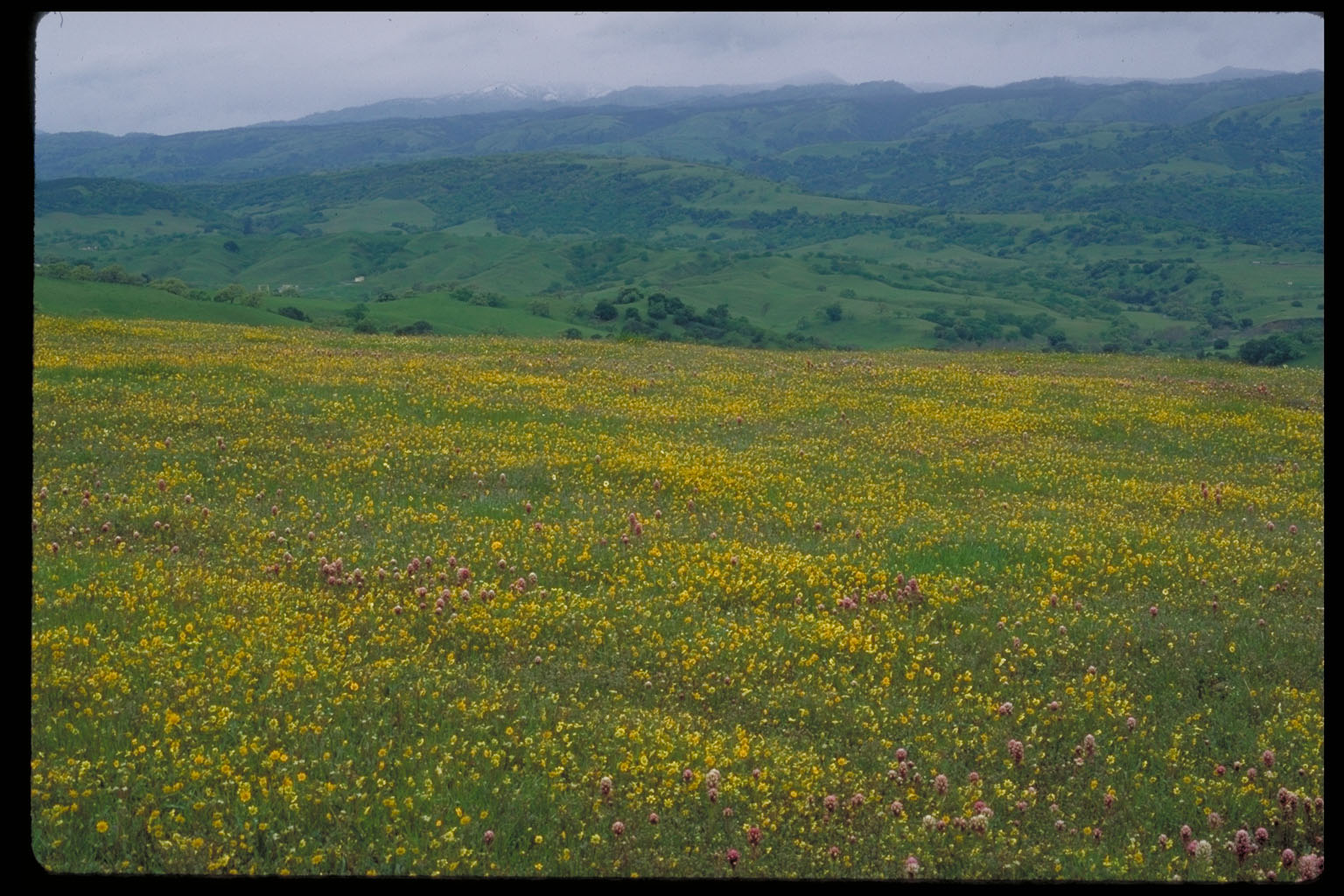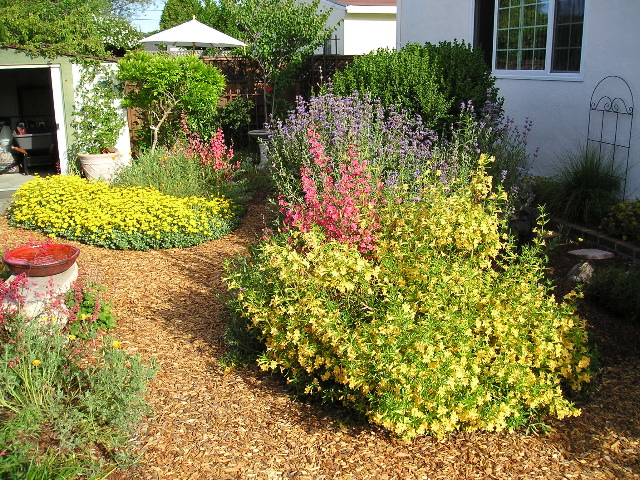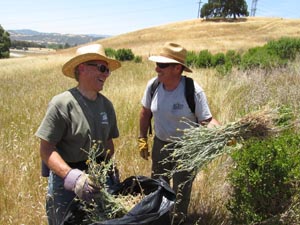Information about how to contact and get involved with the santa clara valley chapter of the Native Plant Society
Articles about our conservation efforts
Edgewood County Park and Natural Preserve is located just west of Redwood City, in San Mateo County. Though just 467 acres, Edgewood is widely known for fabulous wildflower displays and amazing diversity. And as a Natural Preserve, its goal is to protect native species, including over 300 native plants!
Our CNPS chapter has a long and storied history (almost 40 years!) of exploring the Edgewood site before it was even a park, fighting to save it from development, and then working to protect and restore the habitats found there... visit our Edgewood page to learn more of the story, or visit our Edgewood Weed Warriors page to learn how you can help with restoration.
 |
| Spring wildflowers at Coyote Ridge (Photo: Ken Himes) |
Imagine a place of sweeping vistas, singing grasses, wildflowers, eagles, falcons, coyotes, but few people. All this within view of one of the largest metropolitan areas in America. All this two miles from an interstate highway. The hills on the eastern side of the Santa Clara Valley, known collectively as the Diablo Range, are in places made up of a rock known as serpentinite, or more commonly, just serpentine. Coyote Ridge is a block of serpentine fifteen miles long and two miles wide just east of US 101. In the spring it is a mass of wildflowers, right down to the highway. Kestrels can be seen along the highway, hovering as they look for prey. Red-legged frogs can be seen in ponds, and pronghorns can be seen in the hills beyond.
The last healthy populations of the Bay checkerspot butterfly are found along Coyote Ridge, and there are at least fifteen plants identified by the California Native Plant Society as rare or endangered. Since the early 1990's, CNPS-Santa Clara Valley has conducted vegetation surveys, monitored rare plant populations, led field trips, produced videos, brochures and articles, held public meetings, and advocated conservation policies before public bodies. Protection of this treasure has been adopted by the City of San Jose, the Valley Transportation Authority, the Santa Clara County Open Space Authority, the Silicon Valley Land Conservancy and the Nature Conservancy.
For more information, see our Coyote Ridge page
What's going on, we have many programs, field trips native plant sales and more..
Alum Rock Park Wildflower Festival 2014, Coastal Wildflower Day 2015, Wildflower Show at Hidden Villa 2015, etc.
Learn more about Gardening with Natives, the Going Native Garden Tour and Native HIll
 Do you want a garden teeming with life? One that changes with the seasons? One that looks stunning? One that saves water, energy, effort, and money? Consider incorporating California native plants in your garden to attract butterflies, birds, and other wildlife. These beautiful plants will bring seasonal color to your landscape. They will give your California garden a unique sense of place.
Do you want a garden teeming with life? One that changes with the seasons? One that looks stunning? One that saves water, energy, effort, and money? Consider incorporating California native plants in your garden to attract butterflies, birds, and other wildlife. These beautiful plants will bring seasonal color to your landscape. They will give your California garden a unique sense of place.
This website is for gardeners and home owners who want to learn how to grow California native plants in their landscapes. Visit this site to find out about talks, classes, workshops, garden tours, native plant sales, and other events where you can learn more. Visit this site for plant lists and useful articles on the propagation, growth, and care of native plant gardens.
Gardening with Natives is a special interest group of the Santa Clara Valley Chapter of the California Native Plant Society. The group contains a mix of beginners and seasoned professionals, and is a great place to learn. Newcomers are particularly welcome. Gardening With Natives maintains a discussion egroup where people can ask questions, get answers, offer advice, and stay informed about upcoming events. Sign up below to participate in this forum. Membership is voluntary. Email traffic ranges from 10 to 20 messages a day. You can opt for individual emails or a daily digest.
The fall Seed Exchange is held at the Peninsula Conservation Center (PCC) in Palo Alto.
For other queries, contact the Gardening With Natives Steering Committee at This email address is being protected from spambots. You need JavaScript enabled to view it..
 Our Santa Clara Valley Chapter of CNPS supports habitat restoration projects all over Santa Clara County and San Mateo County. We encourage members and supporters to get involved with a restoration project near you, whether at a park or creek or natural area. It is a great way to learn about native plants and their role in the ecology and see firsthand the damage caused by invasive plants. This is also an important way in which everyone can make a difference and help the environment.
Our Santa Clara Valley Chapter of CNPS supports habitat restoration projects all over Santa Clara County and San Mateo County. We encourage members and supporters to get involved with a restoration project near you, whether at a park or creek or natural area. It is a great way to learn about native plants and their role in the ecology and see firsthand the damage caused by invasive plants. This is also an important way in which everyone can make a difference and help the environment.
Our Chapter leads three ongoing restoration projects of its own:
Chapter members support other local ongoing restoration projects. See the annual Ongoing Restoration Projects article from our Blazing Star newsletter for a one-page listing of local projects including workday schedules and contact information.
Habitat Restoration Section Index of articles:
Edgewood County Park and Natural Preserve is located just west of Redwood City, in San Mateo County. Though just 467 acres, Edgewood is widely known for fabulous wildflower displays and amazing diversity. And as a Natural Preserve, its goal is to protect native species, including over 300 native plants!
Our CNPS chapter has a long and storied history (almost 40 years!) of exploring the Edgewood site before it was even a park, fighting to save it from development, and then working to protect and restore the habitats found there... visit our Edgewood page to learn more of the story, or visit our Edgewood Weed Warriors page to learn how you can help with restoration.
Join local volunteers at your favorite parks to help restore habitat for native flora and fauna. Projects include planting California natives, trail maintenance and of course, plenty of weed pulling! Contact the listed organizers for details.
The projects listed here are not sponsored by CNPS. We are looking for volunteers who know about these projects and are willing to help us keep their workday schedules and contact information up to date. If you'd like to help, please contact Carol Mattsson at This email address is being protected from spambots. You need JavaScript enabled to view it..
Upcoming Rare Plant Activities
Calero Park Rare Plant Treasure Hunt
Sunday, April 22, 2012 10 am to 2 pm
Tuesday, April 24, 2012 10 am to 2 pm
Santa Clara County Parks and the Santa Clara Valley Chapter of the Native Plant Society invite you on a treasure hunt for our rare plants at Calero County Park. Volunteers will spread out across the park in search of our rare or endangered plants. Teams will be provided with a GPS unit (or bring your own GPS unit or GPS-enabled mobile phone) and there will be enough experts around to insure accurate identification of the plants. You don't need to have plant keying skills; all that is required is a desire to help and the fitness to walk one to three miles in hilly terrain. Different dates will focus on different areas of the parks. Data collected will be submitted to the California Natural Diversity Data Base, a joint project of CNPS and the California Department of Fish & Game.
To register and obtain meeting locations contact Karen at 408-629-7229 or via emailat This email address is being protected from spambots. You need JavaScript enabled to view it.
Rare Plant Training Workshops
We had a very successful March training with 11 attendees documenting Fritillaria agrestis (stinkbells), photo attached. The Rare Plant committee will have 3 more training in 2012. The purpose of these training sessions is to teach you how document rare plant populations. You will learn how to fill out a California Native Species Field Survey Form, map the rare plant to delineate the population boundaries using a gps, count or estimate the number of individuals, describe the habitat and list the associated species within each population. For more information about the Rare Plant Program see: http://www.cnps.org/cnps/rareplants
The dates and locations will be:
May 12, 2012 – South San Jose
September 22, 2012 – San Mateo County
October 13, 2012 – Santa Clara County
To sign up for one of these trainings email or call Toni Corelli at This email address is being protected from spambots. You need JavaScript enabled to view it." style="color:rgb(0, 0, 255)">This email address is being protected from spambots. You need JavaScript enabled to view it. or (650) 726-0689. Only 10 people will be at each training session, all training will be from 10 am – 2 pm. Location information will be given once you sign up. Approximate locations are given for the dates indicated. Bring lunch and after the training we can walk the trails of the area surveyed.
The Santa Clara Valley Rare Plant Program
Chapter members help locate and document rare and endangered plants. The CNPS Inventory of Rare and Endangered Plants of California (7th ed., print and electronic) lists 94 plants in Santa Clara county and 93 in San Mateo county. This information is also included in the CalFlora Database. In 1995 chapter members Toni Corelli and Zoe Chandik authored the illustrated book The Rare and Endangered Plants of San Mateo and Santa Clara County.
Chapter activity is coordinated by the Rare and Endangered Plant Committee, and is done in cooperation with the State Department of Fish & Game using the department's Natural Diversity Data Base. Committee members submitted successful petitions in 1991 to the Fish and Game Commission requesting listing for three plants under the California Endangered Species Act.
Members interested in participating in Committee work need not have previous experience in botanical field work, though it is helpful. Contact the Rare and Endangered Plants committee chair with questions.
The Santa Clara Valley Chapter brings members with native plant expertise together with local schools, teachers, and PTA members interested in establishing outdoor classroom gardens with native plants as an aid to instruction about botany, biology, and ecology. The chapter maintains a discussion forum of educators and parents interested in school gardens and exchanging ideas and notes. Sign up below to join this mailing list.
| Sign up below to join the CNPS-SCV Education discussion forum. |
| Your email address: |
Peterson Middle School Nature Area, 1380 Visalia Avenue, Sunnyvale
Originally planted approximately 30 years ago, the Nature Area contains well established native plantings from eight biological communities; grassland, pond, swamp, redwood forest, riparian community, deciduous forest, chaparral and bog. TeacherThis email address is being protected from spambots. You need JavaScript enabled to view it. established the two-acre science study area in 1970 and recently established a new pond area. Mr. Osborne is a mentor teacher who has developed curriculum materials and labs for the Nature Area. Peterson Middle School is located in Sunnyvale, within the Santa Clara Unified School District.
Hacienda Science Magnet, 1290 Kimberley Drive, San Jose
Originally planted in 1971, the one-acre Outdoor Classroom is used to introduce children to the natural sciences and horticulture. The Outdoor Classroom was initiated by teacher Edy Young, her husband Joe, and parents. Teacher Carolyn Flanagan has been responsible for programs since Edy's retirement. Beginning in 1992, the San Jose Water Company, the corporate Adopt-A-School partner of Hacienda Science Magnet School, parents, and some 30 Bay Area businesses completely renovated the Outdoor Classroom. These renovations included the construction of new ponds and a stream, a programmable irrigation system, and a 625 square foot covered outdoor study area with benches and tables. Biological communities represented in the Outdoor Classroom include redwood forest, oak woodland, chaparral, grassland, streamside and pond habitats. Hacienda-Valley View School is a K-5 school in the San Jose Unified School District.
Cheeseman Environmental Study Area at De Anza College, corner of Stelling & McClellan, Cupertino
The Cheeseman ESA, located next to the Kirsch Center for Environmental Studies on the southeast corner of the De Anza College campus, is a lush natural garden containing some 400 species of plants representing 12 California natural communities. In addition to the native plant communities, there is a waterwise native plant display at the entrance.
Native Hill, Foothill College, 12345 El Monte Road, Los Altos Hills
Begun in 1982 by former faculty member Robert Will as a teaching aid for students, this small patch of land has grown under the care of CNPS members to house 170 species of native plants.
Dan Lairon Elementary School (formerly Seven Trees School), 3975 Mira Loma Way, San Jose.
The school garden started with a few plants in about 1997. It has slowly evolved into an extensive wildlife habitat and pollinator garden. The students have so much fun helping maintain the garden while observing the critters that visit our school paradise. Many of the school’s classes tour the garden throughout the school year to marvel at and learn from the wonderful things our garden has to offer. There are many habitat plants like elderberries and toyons that also provide berries for birds. The garden also contains dozens of different kind of flowering plants that provide nectar sources for pollinators throughout the year.
Oak School Native Plant Garden, 1501 Oak Avenue, Los Altos
The quarter-acre Native Plant/ Creative Play Garden was completed in August 2005 and features California native species such as redwood, incense cedar, big leaf maple, western sycamore, western redbud, valley and coast live oak, and buckeye trees and an extensive array of bushes, grasses and flowers representative of several California Native Plant communities. With meandering paths, boulders, a sand play pit, play area, a redwood amphitheater, and an old fashioned hand-pump and dry creek bed, this is a popular play area during recess as well as a valuable educational garden used for the study of ecology and habitats. The garden and neighboring redwood trees also provide an official Western Bluebird Trail and features cavity nester bird boxes, which are monitored each spring by students. The boxes have been used by many bluebird and chickadee families!
To add your school or a favorite outdoor education site, please contact Nora Monette: This email address is being protected from spambots. You need JavaScript enabled to view it.